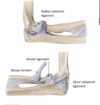LOCO Revision3 Flashcards
Where does the axillary artery run between? [2]
lateral border 1st rib to inferior border of teres major

Brachial plexus
What are the anterior cord nerves [3]
What are the posterior cord nerves [2]
Anterior cord (lateral to medial)
* Musculocutaneous
* Median
* Ulnar
Posterior cord
* Axillary
* Radial

How do you differentiate between fractured clavicle or dislocated shoulder?
Look for rounded profile of the shoulder:
Shoulder dislocation:
* Shoulder squared off – can see acromioclavicular joint
Clavicular fracture:
* Rounded profile of shoulder - SCM pulls medium section upwards. Tenting of the joint
Clavicle on left; shoulder dislocation on right

Which muscle is causing this fractured clavicle to shorten the width of the shoulder? [1]
Pectoralis major (major adductor – brings arm closer) have lifted the shoulder up and shorten the width

Which structure in the shoulder is at risk of damage from shoulder dislocation that increases liklihood of refracture [1]
Glenoid labrum
Describe scapulo-humeral rhythm [2]
Scapula and humerus move in a 1:2 ratio.
When the arm is abducted 180 degrees, 60 degrees occurs by roation of the scapula and 120 degrees by rotation of the humerus at the shoulder joint
Which nerves [2] and muscles [2] are at risk of from axillary lymph node clearance? [2]
Injury to thoracodorsal nerve; Latissimus dorsi
Injury to long thoracic nerve; serratus anterior - causes winging scapula

How does spinal accessory nerve damage present? [4]
- Weak shoulder abduction not as prominent winging of scapula
- Loss of adduction - DOUBLE CHECK
- Atrophy of trapezius
- Shoulder falls
Sternoclavicular joint:
What is the type of joint? [1]
Which structure is present for shock absorption? [1]
Which type of movement does the joint permit? [1] ?
joint type: synovial, saddle joint
shock absoption: articular disc
movements: around 60 degrees when elevate scapula

If you break your clavicle, which structures act and cause different movements of the clavicle? [3]
What do u need to help bring bones back together to heal? [1]
- Sternocleidomastoid muscle: pulls medial aspect of clavicle up
- Pectoralis major muscle pulls arm and clavicle medially
- Gravity will pull down
- need an internal fixation

label these xox
which of these labels are joining points for muscles? [3]

which of these labels are joining points for muscles? [3]
- coracoid process
- supraspinous fossa
- infraspinous fossa

what are two prominent structures / features of the the glenohumeral joint? [2]
Why is this clinically significant [1]
what are two prominent features of the glenohumeral joint?
glenoid cavity accomodates approx/ 1/3 of the humeral head: means that should can have wider range of movement
inferior joint capusule is lax. allows elevate above head. but means is much weaker than superior portion

Which structures deepen the shallow glenoid fossa? [2]
what is the shallow glenoid fossa deepened by? [2]
- glenoid labrum (fibrocart. ring that surrounds articular surface). helps deepen the socket and support the joint
- long head of the biceps - attaches to superior aspect of labrum
label A-E

A: acromioclavicular joint
B: corocoid process
C: clavicle
D: acromion
E: glenoid fossa

Which muscle initates the first 10 degrees of abduction? [1]
supraspinatus



Which of the following is the glenoid labrum?
A
B
C
D
E

Which of the following is the glenoid labrum?
A
B
C
D
E
Which of the following is the acromion?
A
B
C
D
E

Which of the following is the acromion?
A
B
C
D
E
Which of the following is the scapula?
A
B
C
D
E

Which of the following is the scapula?
A
B
C
D
E
Which of the following is the supraspinatus muscle?
A
B
C
D
E

Which of the following is the supraspinatus muscle?
A
B
C
D
E

Which of the following is the glenoid labrum
A
B
C
D
E

Which of the following is the glenoid labrum
A
B
C
D
E
Which of the following is the glenoid cavity
A
B
C
D
E

Which of the following is the glenoid cavity
A
B
C
D
E
What is muscle D? [1]
What is bone E? [1]

D: supraspinatus
E: Acromion
Which of the following is the articular capsule
A
B
C
D
E

Which of the following is the articular capsule
A
B
C
D
E














































